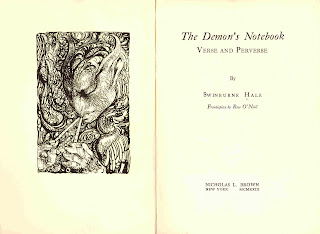Swinburne Hale
(b. Ithaca , New York ,
5 April 1884; d. Westport , Connecticut
Swinburne Hale was the oldest of four children of William
Gardner Hale (1849-1928), Harvard-educated professor of Latin at Cornell
University (from 1880-1892) and afterwards (until retirement in 1920) at the newly
founded University of Chicago, where he also served as head of the Latin
department, and Harriet Swinburne Hale (1853-1928), a graduate of Vassar
College. Swinburne’s siblings included Virginia Swinburne Hale (1887-1981), Margaret Hale
(1891-1962) and Gardner Hale (1894-1931). Virginia and Gardner became artists,
and Gardner
Swinburne
was educated at Philips Exeter Academy ,
and Harvard University New York , he lived in Greenwich
Village , where he made many friends among writers, while he also
became prominent in various liberal groups. In 1921, his partner Walter Nellis
at the New York
In 1910 he
married Beatrice Forbes-Robertson, an actress and niece of Sir Johnstone
Forbes-Robertson. They had three daughters. During World War I he served in France
Swinburne
Hale published his only book in the summer of 1923: The Demon’s Notebook—Verse and Perverse (New York Philadelphia
before moving to New York
The Demon’s Notebook was reviewed
favorably by Henry Longan Stuart in The
New York Times. Stuart wrote: “At his
best and most serious, Mr. Hale is astonishingly good” (July 8, 1923). What Stuart doesn’t say is that for much of
the volume, Hale is not very serious at all.
The result is an unsatisfying book, which will be remembered by
posterity more for the frontispiece than for any of the poems inside. To give a few examples, the first poem in the
book, “The Demon”, begins: “Let the
Demon work in you! / Do not cast him out! / He knows better than you do / What
he is about!”. In the final poem in the
“Verse” section, “Dedication” (To Rose O’Neill), Hale writes:
But you, the Master-Mistress of my mind,
Whose Demon sits high-throned above my stars—
But you, whose passionate pinions know no kind,
Whose scars are burnt with scars—
You will divine my song in your far place,
And call it with your wings, and hold it high;
And underneath the dark of that embrace
Young songs shall cry.
In the “Perverse” section, Hale writes in the poem “The God
in the House”:
God is moving round my house
Setting things to rights.
I hear his step upon the stair,
But like a savant in my lair
Crouch and nurse my fine despair. . . .
He wants to make of this my house
A sanitary sight.
He thinks it has a curious smell—
But I should do so very well
If I could keep my funny hell.
Hale spent
the summer of 1924 in Taos ,
New Mexico
Swinburne
Hale soon left Taos Westport ,
Connecticut


Nice blog, and terrific post about Swinburne Hale. I am researching him and his first wife Beatrice. Am going through her letters to him, 1913-1919, which are in a collection at the NY Public Library. There are also letters in the Ralph M. Pearson collection in New Mexico. By the way, other sources say he and Marie Tudor Garland divorcedin 1924. She also moved out to NM, north of Santa Fe.
ReplyDeleteA friend of mine (in the UK) had some papers of Greta Hale, and asked me to look into her, which resulted in the entry on Swinburne Hale. I'll point him to your comment, and to your website, so he can contact you directly if he has anything relevant. Thanks for writing!
ReplyDeleteHi, I'm Beatrice Forbes-Robertson Hale's great granddaughter. Beatrice wrote a book called Family Legends which I have made available on Amazon if that helps.
ReplyDeleteBest wishes, Nicky Fitzmaurice